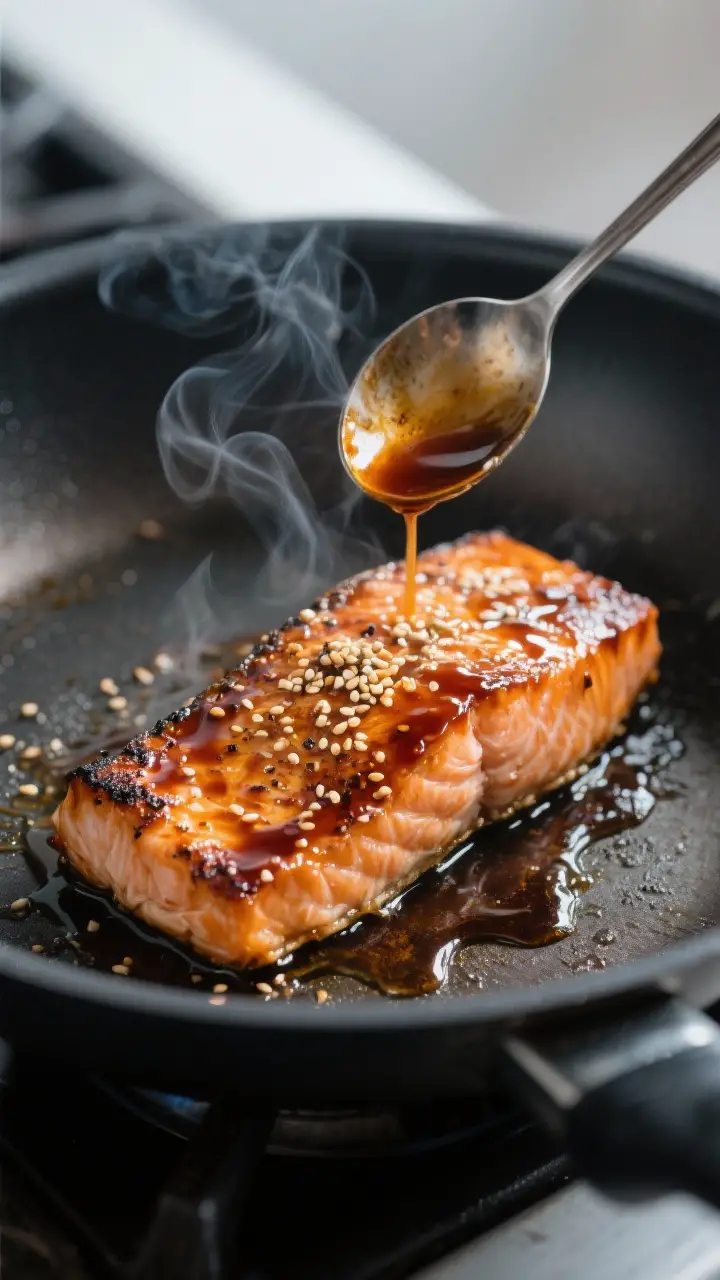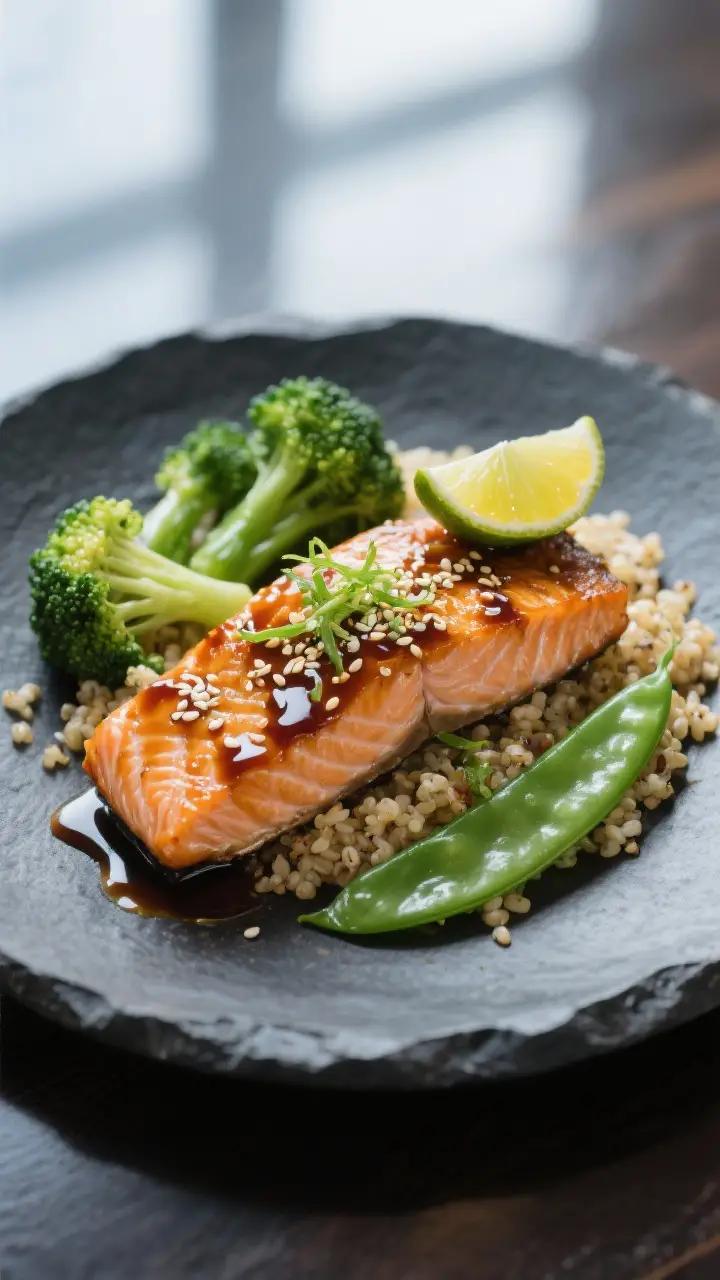Teriyaki Salmon Bowls bring together tender salmon, glossy sauce, warm rice, and crisp veggies in a way that feels both cozy and fresh. The flavors are savory, slightly sweet, and just a little tangy, with a touch of ginger and garlic to keep things lively. Everything cooks quickly, and most of the work happens in one pan.
This is one of those recipes that looks impressive but takes less effort than you think. If you love balanced bowls with great texture and flavor, this one checks every box.
What Makes This Recipe So Good

- Balanced flavor: The homemade teriyaki sauce hits sweet, salty, and umami notes without being cloying.
- Fast and flexible: Salmon cooks in minutes, and you can use any veggies or grains you have on hand.
- Restaurant quality at home: Searing the salmon creates a caramelized crust and tender center.
- Make-ahead friendly: The sauce keeps well, so you can prep it on Sunday and enjoy bowls all week.
- Nutritious and satisfying: Protein-rich salmon pairs with fiber-packed vegetables and whole grains for a complete meal.
What You’ll Need
- Salmon: 4 salmon fillets (about 5–6 oz each), skin-on or skinless
- Rice or grains: 3 cups cooked jasmine rice, brown rice, or quinoa
- Vegetables: 2 cups broccoli florets, 1 cup sliced carrots, 1 red bell pepper (sliced), 1 cup edamame (optional)
- Aromatics: 2 cloves garlic (minced), 1 tablespoon grated fresh ginger
- Oil: 1–2 tablespoons neutral oil (avocado or canola)
- Sesame seeds: For garnish
- Green onions: 2–3, thinly sliced
For the teriyaki sauce:
- 1/3 cup low-sodium soy sauce or tamari
- 1/3 cup water
- 3 tablespoons honey or maple syrup
- 1 tablespoon rice vinegar
- 1 tablespoon mirin (optional, adds depth)
- 1 teaspoon toasted sesame oil
- 1 teaspoon cornstarch mixed with 1 tablespoon water (slurry)
Instructions

- Cook your base: Prepare rice or grains according to package instructions. Fluff and keep warm.
- Make the teriyaki sauce: In a small saucepan, whisk soy sauce, water, honey, rice vinegar, mirin, sesame oil, garlic, and ginger.
Bring to a gentle simmer over medium heat. Stir in the cornstarch slurry and simmer 1–2 minutes until glossy and slightly thickened. Remove from heat.
- Prep the vegetables: Steam or sauté broccoli and carrots until crisp-tender.
Sauté the bell pepper for 2–3 minutes until just softened. If using edamame, warm it according to package directions.
- Pat the salmon dry: Use paper towels to dry fillets well. Season lightly with salt and pepper.
- Sear the salmon: Heat a large nonstick skillet over medium-high.
Add oil. Place salmon skin-side down (or presentation side down if skinless). Sear 3–4 minutes until browned, then flip.
- Glaze and finish: Reduce heat to medium.
Spoon some teriyaki sauce over the salmon. Cook 2–4 more minutes, basting once or twice, until the salmon flakes easily and is just opaque in the center. Don’t overcook.
- Assemble the bowls: Add a scoop of rice to each bowl.
Top with vegetables and a salmon fillet. Drizzle with extra teriyaki sauce.
- Garnish: Sprinkle with sesame seeds and green onions. Serve immediately.
Keeping It Fresh
- Storage: Store components separately when possible.
Salmon keeps 2–3 days in the fridge. Rice and veggies last 3–4 days.
- Reheating: Warm salmon gently at 275–300°F (135–150°C) for 8–10 minutes or in a covered skillet over low heat with a splash of water. Avoid microwaving on high to prevent drying.
- Sauce ahead: The teriyaki sauce keeps up to a week in the fridge.
Reheat and thin with a splash of water if it’s too thick.
- Freezing: Cooked salmon can be frozen up to 2 months. Thaw overnight in the fridge and reheat gently. Fresh veggies are best made day-of.

Health Benefits
- Omega-3s: Salmon is rich in EPA and DHA, which support heart, brain, and joint health.
- High-quality protein: Helps with muscle repair and keeps you full longer.
- Micronutrients: Salmon provides B vitamins, selenium, and potassium.
Veggies add fiber, vitamin C, and antioxidants.
- Balanced macros: Pairing protein, complex carbs, and healthy fats helps steady energy and satisfaction.
- Lower sodium option: Using low-sodium soy sauce and controlling the sauce at home keeps salt in check.
Pitfalls to Watch Out For
- Overcooking salmon: It goes from silky to dry quickly. Pull it when the center is just opaque or at 125–130°F (52–54°C) for medium.
- Too-sweet sauce: Balance honey with acid (rice vinegar) and umami (soy). Taste and adjust before glazing.
- Watery veggies: Don’t crowd the pan.
Cook in batches to keep them crisp.
- Soggy skin: If using skin-on salmon, start skin-side down in a hot pan and don’t move it for a few minutes.
- Sticky sauce in the pan: Lower the heat after searing; glaze gently to avoid burning the sugars.
Variations You Can Try
- Spicy teriyaki: Add a teaspoon of sriracha or a pinch of red pepper flakes to the sauce.
- Citrus twist: Finish with a squeeze of orange or lime juice and zest for brightness.
- Veggie swap: Try snap peas, bok choy, zucchini, or shredded cabbage. Use what’s in season.
- Grain bowl: Swap rice for brown rice, quinoa, farro, or cauliflower rice for a lighter option.
- Sheet pan method: Roast salmon and veggies together at 400°F (205°C) for 10–14 minutes, glazing halfway through.
- Air fryer: Cook salmon at 380°F (193°C) for 7–10 minutes, brushing with sauce twice.
- Gluten-free: Use tamari or coconut aminos and confirm all ingredients are GF.
FAQ
Can I use frozen salmon?
Yes. Thaw it overnight in the fridge, then pat it very dry before searing to get good browning and avoid splatter.
What’s the best salmon to buy?
Look for fresh, firm fillets with a mild smell.
Skin-on works well for searing. If available, choose responsibly sourced or wild-caught salmon for great flavor and texture.
Can I bake the salmon instead of pan-searing?
Absolutely. Bake at 400°F (205°C) for 10–14 minutes, depending on thickness.
Brush with sauce during the last few minutes to set the glaze.
How do I thicken teriyaki sauce without cornstarch?
Simmer longer to reduce, or use arrowroot or potato starch. Mix the starch with cold water first to avoid lumps.
What vegetables go best in these bowls?
Broccoli, carrots, bell peppers, snap peas, and edamame are reliable. Aim for a mix of colors and textures—some crunchy, some tender.
How do I keep the sauce from being too salty?
Use low-sodium soy sauce, add more water if needed, and balance with honey and vinegar.
Taste and adjust before it hits the pan.
Can I meal prep these bowls?
Yes. Store salmon, rice, veggies, and sauce separately. Assemble just before eating, and add sauce after reheating for the best texture.
In Conclusion
Teriyaki Salmon Bowls are proof that a quick dinner can still feel special.
With a simple homemade sauce, juicy salmon, and bright vegetables, you get a complete meal that satisfies without weighing you down. Keep the pantry staples on hand, and this becomes an easy weeknight habit. Once you try it, you’ll find endless ways to make it your own.
Printable Recipe Card
Want just the essential recipe details without scrolling through the article? Get our printable recipe card with just the ingredients and instructions.

